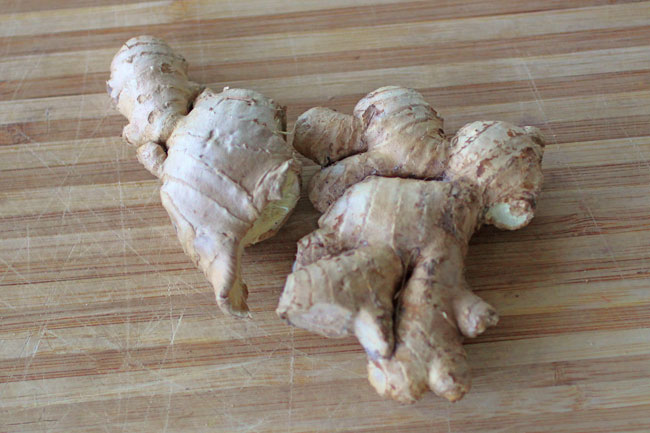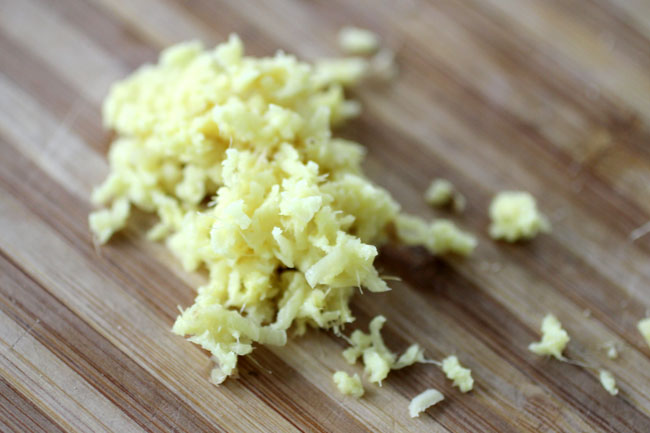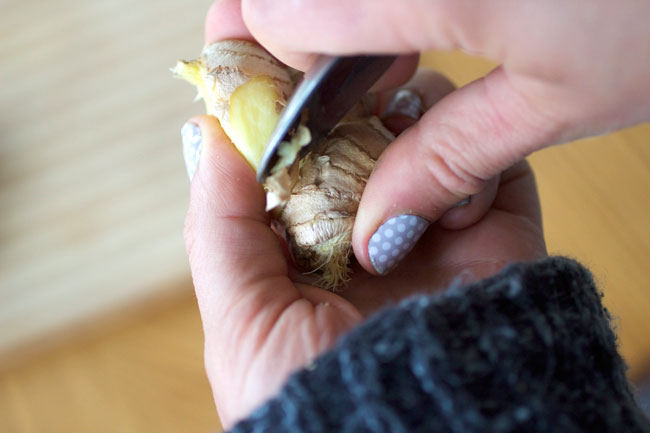Ginger is a natural remedy that has been around for centuries. Treatises from China dating as far back as 400 BC are filled with praise for this brilliant yellow botanical. The fragrant, peppery, and warming qualities of the ginger root have made it a coveted spice that is sipped as a popular tea, used in many nutraceuticals, and found in beloved dishes from all around the world. There is also a growing body of scientific literature to support its targeted therapeutic use in preventing and treating modern afflictions as diverse as depression, arthritis, and cancer. In this article, we'll explore 5 ginger root facts you should know about! We'll cover the exact properties that make ginger so healing and the benefits of eating ginger. We'll also provide you with a convenient kitchen tip for peeling fresh ginger so that it can be more easily incorporated into your diet.

1. Where does ginger come from?
The knotted stubs that we know simply as "ginger" are actually the underground stem, or rhizome, of the larger Zingiber officinale plant; more commonly called the ginger root. There are two other plants in the Zingiberaceae botanical family: turmeric and cardamom. From its humble beginnings in the soil, the main stem of the ginger plant rises out of the ground for about 12 inches and becomes decorated with narrow, ribbed leaves and dainty white or yellow-green flowers. The above-ground display is outwardly impressive, but it is actually the underground rhizome of the ginger plant that holds the most therapeutic benefit. The fibrous ginger roots do certainly look boring when first unearthed –all brown and wrapped round with a papery outer layer– however when peeled, a startling vibrant yellow or orange core is revealed. It is this colorful "flesh" from the root that is filled with cherished and health-giving aromatic compounds. Although ginger can now be found in most grocery stores and markets, the plant is native to southeastern Asia where the rhizomes have been harvested for use as a cooking spice and medicinal substance for thousands of years. 1

2. What are the health benefits of ginger?
Many Eastern systems of medicine including Chinese and Ayurvedic traditions, classically use ginger to treat stomach upset, diarrhea, and nausea as well as headaches and common cold and flu-like symptoms. In modern herbal medicine ginger is revered as a potent carminative (a substance that promotes the elimination of intestinal gas) and intestinal spasmolytic (a substance that relaxes and soothes the intestinal tract). 2
Researchers have now surmised that the active components of the ginger root are volatile oils and concentrated phenol compounds, such as gingerols and shogaols. Together these substance work in the body to modulate the digestive and immune systems in curative, balancing ways. Ginger has been found to have more than 40 unique pharmacological actions, and while I won't bore you with the technical underpinnings of each one, there is a handful that I think are important to share. 3
Some of the health benefits of eating ginger include:
1. Anti-Inflammatory Effects: Ginger is full of a unique form of activated protease, or a type of enzyme that helps to break down specific proteins into amino acids. The protease variety found in ginger works specifically in inflammation-related pathways to reduce pain and prevent the release of pro-inflammatory compounds (like cytokines and chemokines) that can damage the body when present in excess. A major health benefit of eating ginger comes from its anti-inflammatory effects. These effects are far-reaching and can be helpful for relieving pain in acute conditions such as muscle injury, migraine headaches, or menstrual cramps, and also helping to shift the trajectory of more chronic issues such as IBS, joint disease, and fibromyalgia. 4
2. Broad Spectrum Antibacterial, Antifungal, and Antiviral: Ginger has numerous compounds that carry anti-microbial properties. Gingerols, gingerol, and galanolactone are just a few of these important substances, and each is designed to destroy a specific type of pathogen. Given this diversity, it is easy to see why ginger has been found helpful in targeting many different kinds of infections including the common cold, oral bacterial growth, H. Pylori, and candida 5
3. Blood Sugar Regulator: This may seem like a strange one, but studies show that one of the most interesting benefits of eating ginger is its ability to help with the management of high blood sugar, otherwise called hyperglycemia. It does so by inhibiting enzymes used for carbohydrate breakdown, regulating insulin sensitivity and release, and improving lipid metabolism. Research also shows that ginger has notable protective effects against the common complications of dysregulated blood sugar. This includes the prevention of damage to the liver, kidneys, eyes, and neural system as is often seen with diabetes mellitus. 6
4. Powerful Antioxidant Capacity: Ginger contains several powerful compounds including gingerol, shogaol, and zingerone, that help to reduce the harmful effects of free radicals and oxidative stress. In isolation and when consumed in whole-food form, these compounds have proven highly effective in protecting the body from exposure to environmental toxins and from the inherent damages of chronic stress and disease. 7
5. Gastrointestinal Relief: As mentioned above, one of the most widely known benefits of eating ginger is its ability to assist in healthy digestion. The natural chemicals in the root work to promote the emptying of the stomach and intestines and also encourage the elimination of gas. Researchers also believe that ginger works in the brain and nervous system to control related symptoms including nausea, dizziness, and cold sweating. 8
3. What is the best way to consume ginger?
Today ginger is available to us in many forms. At the health food store you will find a medley of ginger extracts, tinctures, oils, powders and capsules. At most grocery stores you will find ginger breads, cookies, beers and sodas. But, as with most things we talk about on this blog, it is important to keep in mind that not all ginger products are created equal. Most packaged food items won't have enough (if any) authentic ginger to prove beneficial. Dried ginger may quickly loose its potency if it has been irradiated or stored for long periods of time. And when searching for a supplement, double-check the ingredient list to see that the product is in fact derived from whole, real ginger (preferably organic) and that it is free from fillers and unwanted excipients too.
The real answer to this question about the ideal form of ginger is that it depends. Studies have used a wide variety of formulations to achieve therapeutic effects in different patient groups. Yet, while more critical health concerns may call for concentrated supplement use under the supervision of a health care provider, by far the least expensive and most convenient way to get ginger into the diet is to go directly to the source. Try purchasing fresh ginger, which can usually be found in the produce section of the grocery store. This versatile root can be used to make a variety of dishes including Asian stir-fries, sauces, dressings and (my personal favorite) homemade teas. A little goes a long way and fresh ginger roots stay good for about 3 weeks in the refrigerator if unpeeled or can be frozen for longer-term storage.
4. Is ginger safe to eat and use?
Speaking broadly, the answer is yes. Ginger has a relatively low allergenic profile and it tends to be well-tolerated by most healthy adults. This is especially true when using a whole food form, as the plant naturally contains all of the necessary co-factors for proper assimilation. That having been said, we are all different, so use your own judgment and listen to your body to figure out what will work best for you. It is not recommended for children under the age of 2. In the case of supplements, most professional sources advise starting with no more than 1 gram per day. People taking blood-thining, blood-pressure lowering or blood-sugar regulating medications are also cautioned to work with a health care practitioner before incorporating large amounts of ginger as it may amplify effects.
5. How do you peel fresh ginger?
Most people find that the largest obstacle to using fresh ginger is peeling it. After all it is called Singabera meaning "horn-shaped" in Sanskrit, a term that pays homage to its intricate shape. The outer skin will also vary in thickness depending on how mature the plant was at the time of harvest. An older rhizome will generally have a tough and dense outer layer (this is what you will usually find at the grocery store), while younger ginger plants will yield a more delicate coating around the root.
Removing this outer layer before using ginger in cooking is not an absolute necessity- it is technically edible and not necessarily dangerous. However peeling it back definitely helps contribute to the release of flavor and helpful compounds, and also removes the risk of having gritty little pieces floating around in your meal or beverage.
I have found that peeling ginger can actually be quite easy with this trick: simply run the edge of a spoon along the ginger in a scraping motion and the skin comes right off. That's all there is to it! No sharp objects or fancy tools required.
Try it out for yourself and tell me about your favorite ways to use ginger!

